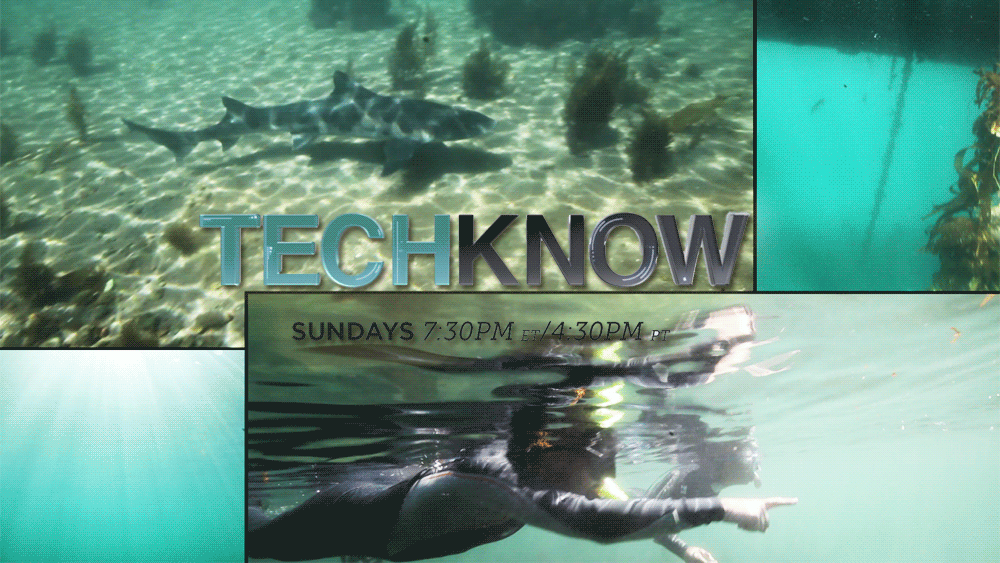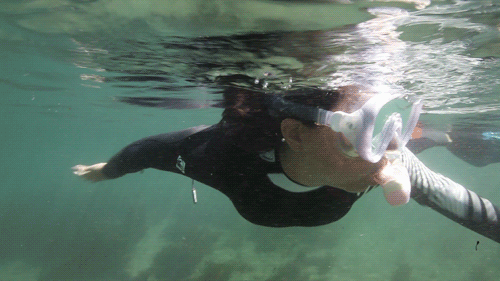Modifying older robot technology to study the ocean’s sharks in new ways
On this week’s “TechKnow,” contributor Marita Davison swims with sharks as she explores new robotic technology that is allowing scientists to study these ocean predators like never before.
“This is going to change how we study animals in the ocean,” says Dr. Chris Lowe. “I really believe this is going to change how we do it.”

Growing up on Martha’s Vineyard, an island located south of Cape Cod in Massachusetts, Lowe’s passion for studying the ocean and its inhabitants started at an early age.
“All there was to do was fish and swim, get in the water and dive,” he says. “When I caught my first shark, there was something about it that just got me. It was the look—it looked so different from all the other fish I caught, and it seemed so streamlined, so sleek.”
The passion for sharks lead him to the California State University at Long Beach where, as the director of the university's Sharklab, he studies the hundreds of leopard sharks off the coast of Catalina Island in Southern California.

“They’re a model species,” Lowe says of sharks. “Most of them are at the top of the food chain. I look at those as our canaries. They’re a ‘canary in a coal mine’ for oceans. They tell us how healthy our oceans are.”
One obstacle scientists have found is the challenge of observing the sharks without affecting their behavior.
“You jump in the water and you want the sharks to come to you and sometimes they do, but most times they don’t,” Lowe says. “That’s always been the tricky part. How do we find a way of studying them where we don’t have to be right there, potentially influencing their behavior?”
Lowe has found an answer to that question in a torpedo-shaped autonomous underwater vehicle (AUV), a robot that powers itself through the ocean, tracking and collecting data on sharks and other animals.
“Once it dives down, it uses a couple other sensors, a compass, and something called a doppler velocity log,” explains Chris Clark, the director of the Lab for Autonomous and Intelligent Robotics at Harvey Mudd College.
The AUV uses “hydrophones”—underwater microphones—to listen for acoustic tags that the scientists have attached to fish and sharks. The tags send out a “ping” every few seconds that the hydrophones pick up and locate, allowing the robot to track and monitor the sharks and surrounding ocean without affecting its behavior.
“We basically put this thing in the water, it listens for the tags attached to the sharks, and it will actually autonomously drive around and follow the sharks as they move,” Clark explains to Davison.
The researchers test the robot in the waters off Catalina Island by hiding a transmitter on the ocean floor and sending the AUV out to lock on to its position. When the torpedo-shaped vehicle begins circling, the scientists know it has found its target.
Robots like this have been used for about a decade by oceanographers to measure characteristics of the ocean such as water temperature, light, salinity, and chlorophyll, but Lowe and his team are using it in a slightly different way.
“We’re asking the robot to do one more thing,” he says. “We want them to actually follow a shark and characterize the environment so that we can build a 3D map around the animal that it’s tracking and it knows exactly where the animal is in that 3D space as it’s moving.”
His hope is that by being able to better observe the elusive sharks, he and his team will be able to better understand changes in the animals’ behavior.

“We haven’t been able to do this before,” he says. “It’s revolutionizing how we’re going about studying the animals that we know nothing about.
The technology also has the potential to be useful beyond the realm of scientific research. By attaching tags to their fish, commercial fishery managers can track their stocks if catch rates start to decline, making sure their fish haven’t simply relocated.
“Our ability to understand that means managers can better manage fisheries,” Lowe says. “We can better manage many of our fish stocks. That’s just one example of how knowing where animals go can be beneficial in terms of management.”
Just one example, as Lowe strongly believes that his work with sharks is only the beginning of this technology’s potential.
“I envision a day when we’re going to have fleets of these robots,” he says. “They’re going to enable us to do things that we’ve never been able to do before, measure aspects of behavior that we’ve never been able to measure before. We’re going to build a database of the ocean that’s never been created at this scale. I think this is going to change our field.”
Watch "TechKnow," Sundays at 7:30PM ET/4:30PM PT on Al Jazeera America.
Error
Sorry, your comment was not saved due to a technical problem. Please try again later or using a different browser.